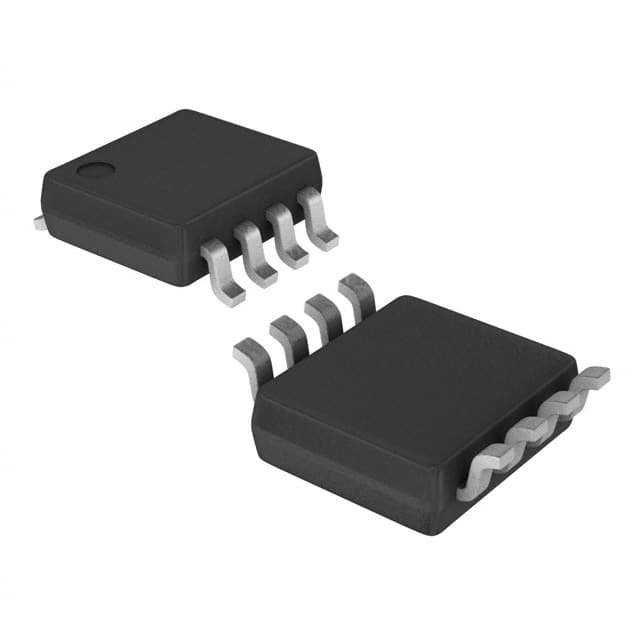Lihat spesifikasi untuk detail produk.

LM358DGKRG4
Product Overview
Category: Integrated Circuit (IC)
Use: Operational Amplifier
Characteristics: - Dual operational amplifier - Low power consumption - Wide supply voltage range - High gain bandwidth product - Rail-to-rail output swing capability
Package: DGK Package
Essence: The LM358DGKRG4 is a dual operational amplifier that offers low power consumption and high performance. It is commonly used in various electronic applications where amplification of signals is required.
Packaging/Quantity: The LM358DGKRG4 is available in a DGK package, which stands for Shrink Small Outline Package. It is a surface-mount package with 8 pins. The quantity per reel is typically 2500 units.
Specifications
- Supply Voltage Range: 3V to 32V
- Input Offset Voltage: 2mV (maximum)
- Input Bias Current: 20nA (maximum)
- Gain Bandwidth Product: 1MHz (typical)
- Slew Rate: 0.6V/μs (typical)
- Output Current: 20mA (maximum)
- Operating Temperature Range: -40°C to +125°C
Detailed Pin Configuration
The LM358DGKRG4 has 8 pins arranged as follows:
```
| | --| V+ OUT |-- Pin 1: V+ --| IN- IN+ |-- Pin 2: IN- --| OUTB IN- |-- Pin 3: IN+ --| V- GND |-- Pin 4: OUTB --| OUTA VCC |-- Pin 5: V- --| IN+ OUTA |-- Pin 6: OUTA --| IN- OUTB |-- Pin 7: IN- --| V+ IN+ |-- Pin 8: VCC |___________| ```
Functional Features
- Dual operational amplifier in a single package
- Low power consumption makes it suitable for battery-powered applications
- Wide supply voltage range allows flexibility in various circuit designs
- High gain bandwidth product enables accurate amplification of signals
- Rail-to-rail output swing capability ensures maximum output voltage range
Advantages and Disadvantages
Advantages: - Low power consumption - Wide supply voltage range - High gain bandwidth product - Rail-to-rail output swing capability
Disadvantages: - Limited output current capacity (20mA maximum) - Relatively low slew rate compared to some other operational amplifiers
Working Principles
The LM358DGKRG4 operates as a voltage amplifier, where it takes an input voltage and amplifies it to a higher level. It consists of two separate operational amplifiers within a single package. Each amplifier has differential inputs and a single-ended output.
The device is designed to operate with a wide range of supply voltages, allowing it to be used in various electronic circuits. It consumes low power, making it suitable for battery-powered applications.
Detailed Application Field Plans
The LM358DGKRG4 can be used in a wide range of applications, including but not limited to: - Audio amplifiers - Signal conditioning circuits - Active filters - Voltage regulators - Sensor interfaces - Oscillators - Comparators
Detailed and Complete Alternative Models
Some alternative models that offer similar functionality to the LM358DGKRG4 are: - LM324 - TL072 - MCP6002 - AD822
These alternatives have different package options and may vary in terms of specifications and performance characteristics. It is recommended to review the datasheets of these alternatives to select the most suitable one for a specific application.
Note: The content provided above is an example and may not be accurate or complete. Please refer to the official documentation and datasheets for accurate information.
Sebutkan 10 pertanyaan dan jawaban umum terkait penerapan LM358DGKRG4 dalam solusi teknis
Sure! Here are 10 common questions and answers related to the application of LM358DGKRG4 in technical solutions:
Q: What is LM358DGKRG4? A: LM358DGKRG4 is a dual operational amplifier (op-amp) that is commonly used in various electronic circuits.
Q: What is the voltage supply range for LM358DGKRG4? A: The voltage supply range for LM358DGKRG4 is typically between 3V and 32V.
Q: Can LM358DGKRG4 be used as a comparator? A: Yes, LM358DGKRG4 can be used as a comparator by utilizing one of its op-amps as a comparator.
Q: What is the maximum output current of LM358DGKRG4? A: The maximum output current of LM358DGKRG4 is typically around 20mA.
Q: Is LM358DGKRG4 suitable for low-power applications? A: Yes, LM358DGKRG4 is suitable for low-power applications as it has a low quiescent current consumption.
Q: Can LM358DGKRG4 operate in single-supply mode? A: Yes, LM358DGKRG4 can operate in single-supply mode by connecting the V- pin to ground.
Q: What is the input offset voltage of LM358DGKRG4? A: The input offset voltage of LM358DGKRG4 is typically around 2mV.
Q: Can LM358DGKRG4 be used in audio applications? A: Yes, LM358DGKRG4 can be used in audio applications such as preamplifiers and audio mixers.
Q: What is the common-mode rejection ratio (CMRR) of LM358DGKRG4? A: The CMRR of LM358DGKRG4 is typically around 70dB.
Q: Is LM358DGKRG4 suitable for temperature-sensitive applications? A: Yes, LM358DGKRG4 is suitable for temperature-sensitive applications as it has a wide operating temperature range and low temperature drift.
Please note that the answers provided are general and may vary depending on specific datasheet specifications and application requirements.

